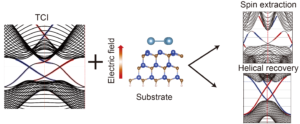‘Trimming’ the edge-states of a topological insulator yields a new class of material featuring unconventional ‘two way’ edge transport in a new theoretical study from Monash University, Australia.
The new material, a topological crystalline insulator (TCI) forms a promising addition to the family of topological materials and significantly broadens the scope of materials with topologically nontrivial properties.
Its distinctive reliance on symmetry also paves the way for novel techniques to manipulate edge transport, offering potential applications in future transistor devices. For example, ‘switching’ the TCI via an electric field that breaks the symmetry supporting the nontrivial band topology, thus suppressing the edge current.
This ground-breaking discovery significantly advances our fundamental understanding of how spin currents travel in topological materials, providing valuable insights into the behaviour of these intriguing systems.
Challenging the common definition of topological insulators
Let’s begin by quoting the elegant definition of topological insulators according to the vision of FLEET:
“Topological insulators conduct electricity only along their edges, and strictly in one direction. This one-way path conducts electricity without loss of energy due to resistance.”
However this new theoretical study, conducted by the computational group at Monash University, challenges that standard topological-physics view by uncovering a new type of edge transport, which prompts reconsideration of the phrase ‘strictly in one direction’.
Modifying this phrase is not a simple task. The topological material is akin to a large tree rooted in the solid soil of ‘bulk–edge correspondence’, meaning that the intrinsic properties of the bulk will dictate the nature of the edge current.
Just as a tree requires pruning to maintain its shape and health, the edge states of a topological material also need to be tailored to adapt towards various applications in electronics and spintronics.
The research team successfully achieved the objective of extracting a new type of edge spin current in a 2D topological material, planar bismuthine, by proposing a novel method to manipulate edge states through bulk-edge interactions, similar to the pruning work done in gardening routines.
This groundbreaking discovery will significantly advance our fundamental understanding of how spin currents travel in topological materials, providing valuable insights into the behaviour of these intriguing systems.
Unconventional spin texture hidden in the symmetry-protected topology
The newly discovered material, named a topological crystalline insulator (TCI), stands as a promising addition to the family of topological materials, operating on the principle that conducting edge currents remain resilient as long as specific crystalline symmetries exist within the bulk.
The discovery of TCI significantly broadens the scope of materials with topologically nontrivial properties. Its distinctive reliance on symmetry also paves the way for novel techniques to manipulate edge transport, offering potential applications in transistor devices.
For instance, by subjecting TCI to a strong electric field, the edge current can be suppressed when the symmetry supporting the nontrivial band topology is broken. Once the field is removed, the conducting edge currents promptly return, showcasing TCI’s advantageous on-demand switch property, ideal for integration into transistor devices.
Beyond offering an alternative form of topological protection, the exciting potential of TCI goes further. The research team has uncovered an unconventional type of spin transport hidden within the edge of two-dimensional TCI bismuthene, a phenomenon previously overlooked in prior reports.

FLEET Chief Investigator Prof Nikhil Medhekar (Monash) performs first-principles quantum simulations on massively parallel high-performance computing systems to investigate the electronic structure of atomically thin topological insulators and interfaces.
“While the common belief is that TCI exhibits the same edge transport mode observed in topological insulators, where each stream of spin current (spin-up or spin-down) strictly travels in one direction, our findings reveal that TCI planar bismuthene hosts a new type of spin transport protected by mirror symmetry,” explains lead author Dr Yuefeng Yin, a research fellow at Monash.
In this mode, the spin current is no longer confined to fixed directions along the edge.”
This new-found spin transport mode unlocks innovative design concepts for topological devices, enabling support for “both pure charge current without net spin transport, and pure spin currents without net charge transport”—a possibility not comprehensible in conventional understanding of topological materials.
“This discovery opens up a new path toward achieving FLEET’s goal of creating low-energy-consuming electronic devices,” adds corresponding author Prof Nikhil Medhekar, also affiliated with Monash.
“While identical spin-polarised streams travelling in opposing directions may not seem immediately useful, they offer new opportunities for spin manipulation that are otherwise inaccessible in other topological materials.”
The research team anticipates that this computational breakthrough will inspire further follow-up studies, both experimental and theoretical, to fully harness the potential of this novel edge transport in electronic and spintronic applications.
Extracting the spin current with bulk-edge interactions

Bulk-edge interactions to tune the edge spin texture of TCI planar bismuthene (image by Dr Yuefeng Yin)
Following the discovery of an unconventional spin texture in 2D TCI planar bismuthene, the research team’s objective is to extract the exotic spin currents from the entangled edge bands by utilizing bulk-edge interactions.
The term ‘bulk-edge interactions’ refers to employing various tuning strategies, such as applying external electric fields and substrate potentials, to selectively adjust the alignment between the bulk and edge bands while preserving the bulk band topology.
“By carefully choosing the tuning factors, we can isolate specific branches of edge states from the original entangled configuration,” explains Dr. Yuefeng Yin.
“This is crucial for further investigating the unconventional spin texture we have identified. Another advantage of this approach is that we can retain the protection offered by the intact bulk-edge correspondence.”
Through the use of a large external electric field and weak substrate potential, the research team can isolate the unconventional spin texture within the edge, effectively concealing the conventional spin transport components in the bulk.
Moreover, these bulk-edge interactions allow for the existence of conducting edge channels even under the influence of a large external electric field, in contrast to the common understanding that applying an electric field opens a band gap in the edge region.
The research team has also demonstrated the ability to revert the edge region back to a fully conventional spin transport setup, akin to what is observed in topological insulators, by applying substrate potentials to selective orbitals.
Prof. Nikhil Medhekar remarks “This is a truly remarkable finding. Not only have we uncovered a new type of edge spin texture in topological materials, but we have also demonstrated an effective way to manipulate and preserve it while maintaining the rigorous bulk-edge topology.”
The research team anticipates that these innovative ‘topological gardening techniques’ can be extended to other topological systems, offering efficient and flexible means to manipulate edge currents.
Bulk-edge interactions to tune the edge spin texture of TCI planar bismuthene (image by Dr Yuefeng Yin)
The Study
Extracting unconventional spin texture in two dimensional topological crystalline insulator bismuthene via tuning bulk-edge interactions was published in Materials Today Physics in July 2023. (DOI: 10.1016/j.mtphys.2023.101168)
The methodology used in this paper is developed from earlier FLEET collaboration between Monash and RMIT titled Localized Wannier function based tight-binding models for two-dimensional allotropes of bismuth, published in New Journal of Physics in June 2021. (DOI: 10.1088/1367-2630/ac04c9)
As well as support from the Australian Research Council, the study utilized computational resources from the Australian National Computational Infrastructure (NCI) and the Pawsey Supercomputing Centre.
More Information
- Contact FLEET Research Fellow Dr Yuefeng Yin (Monash) yuefeng.yin@monash.edu
- Contact FLEET CI Prof Nikhil Medhekar (Monash) nikhil.medhekar@monash.edu



